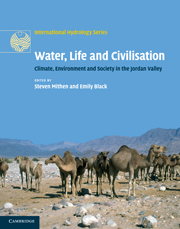Book contents
- Frontmatter
- Contents
- List of figures
- List of tables
- List of contributors
- Acknowledgements
- 1 Introduction: an interdisciplinary approach to Water, Life and Civilisation
- Part I Past, present and future climate
- Part II The palaeoenvironmental record
- Part III Hydrological studies of the Jordan Valley
- Part IV Human settlement, climate change, hydrology and water management
- Part V Palaeoeconomies and developing archaeological methodologies
- Part VI Society, economy and water today
- Part VII Conclusions
- 29 Overview and reflections: 20,000 years of water and human settlement in the southern Levant
- Index
- Plate section
- References
29 - Overview and reflections: 20,000 years of water and human settlement in the southern Levant
from Part VII - Conclusions
Published online by Cambridge University Press: 26 April 2011
- Frontmatter
- Contents
- List of figures
- List of tables
- List of contributors
- Acknowledgements
- 1 Introduction: an interdisciplinary approach to Water, Life and Civilisation
- Part I Past, present and future climate
- Part II The palaeoenvironmental record
- Part III Hydrological studies of the Jordan Valley
- Part IV Human settlement, climate change, hydrology and water management
- Part V Palaeoeconomies and developing archaeological methodologies
- Part VI Society, economy and water today
- Part VII Conclusions
- 29 Overview and reflections: 20,000 years of water and human settlement in the southern Levant
- Index
- Plate section
- References
Summary
As noted at the start of this volume, the Water, Life and Civilisation (WLC) project aimed:
to assess the changes in the hydrological climate of the Middle East and North Africa (MENA) region and their impact on human communities between 20,000 BP and AD 2100, with a case study of the Jordan Valley.
The 28 chapters within this volume have certainly made a contribution towards that aim, although inevitably falling short of providing a comprehensive coverage of the vast array of topics that would need to be addressed to meet that aim in full. In this overview, we will highlight selected conclusions made as part of the project, and those areas of research that have now been revealed to require further attention. We will reflect on the challenges involved in developing interdisciplinary research within our study region, the overall achievements and the shortcomings of our project.
MODELS FOR PRESENT, PAST AND FUTURE CLIMATE CHANGE
The analysis of present-day rainfall and the modelling of past, present and future climates within Chapters 2, 3 and 4 have provided a series of studies of the Middle East and Mediterranean region climate throughout the Holocene and forward to the end of the current century, with sufficient resolution to assess regional climate variability. The use of similar (although not identical) model set-ups to simulate the past and future climate provided an unprecedented opportunity to compare the past, present and future (Chapter 8).
- Type
- Chapter
- Information
- Water, Life and CivilisationClimate, Environment and Society in the Jordan Valley, pp. 469 - 480Publisher: Cambridge University PressPrint publication year: 2011
References
- 3
- Cited by

